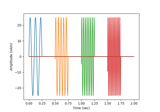mne.simulation.add_eog¶
-
mne.simulation.add_eog(raw, head_pos=None, interp='cos2', n_jobs=1, random_state=None, verbose=None)[source]¶ Add blink noise to raw data.
- Parameters
- rawinstance of
Raw The raw instance to modify.
- head_pos
None|str|dict|tuple|array Name of the position estimates file. Should be in the format of the files produced by MaxFilter. If dict, keys should be the time points and entries should be 4x4
dev_head_tmatrices. If None, the original head position (frominfo['dev_head_t']) will be used. If tuple, should have the same format as data returned byhead_pos_to_trans_rot_t. If array, should be of the form returned bymne.chpi.read_head_pos().- interp
str Either ‘hann’, ‘cos2’ (default), ‘linear’, or ‘zero’, the type of forward-solution interpolation to use between forward solutions at different head positions.
- n_jobs
int The number of jobs to run in parallel (default 1). Requires the joblib package.
- random_state
None|int| instance ofRandomState If
random_stateis anint, it will be used as a seed forRandomState. IfNone, the seed will be obtained from the operating system (seeRandomStatefor details). Default isNone. The random generator state used for blink, ECG, and sensor noise randomization.- verbosebool,
str,int, orNone If not None, override default verbose level (see
mne.verbose()and Logging documentation for more). If used, it should be passed as a keyword-argument only.
- rawinstance of
- Returns
- rawinstance of
Raw The instance, modified in place.
- rawinstance of
See also
Notes
The blink artifacts are generated by:
Random activation times are drawn from an inhomogeneous poisson process whose blink rate oscillates between 4.5 blinks/minute and 17 blinks/minute based on the low (reading) and high (resting) blink rates from [1].
The activation kernel is a 250 ms Hanning window.
Two activated dipoles are located in the z=0 plane (in head coordinates) at ±30 degrees away from the y axis (nasion).
Activations affect MEG and EEG channels.
The scale-factor of the activation function was chosen based on visual inspection to yield amplitudes generally consistent with those seen in experimental data. Noisy versions of the activation will be stored in the first EOG channel in the raw instance, if it exists.
References
- 1
Bentivoglio et al. “Analysis of blink rate patterns in normal subjects” Movement Disorders, 1997 Nov;12(6):1028-34.

